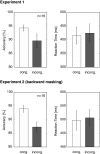Action observation can prime visual object recognition
- PMID: 19669130
- PMCID: PMC2820217
- DOI: 10.1007/s00221-009-1953-8
Action observation can prime visual object recognition
Abstract
Observing an action activates action representations in the motor system. Moreover, the representations of manipulable objects are closely linked to the motor systems at a functional and neuroanatomical level. Here, we investigated whether action observation can facilitate object recognition using an action priming paradigm. As prime stimuli we presented short video movies showing hands performing an action in interaction with an object (where the object itself was always removed from the video). The prime movie was followed by a (briefly presented) target object affording motor interactions that are either similar (congruent condition) or dissimilar (incongruent condition) to the prime action. Participants had to decide whether an object name shown after the target picture corresponds with the picture or not (picture-word matching task). We found superior accuracy for prime-target pairs with congruent as compared to incongruent actions across two experiments. Thus, action observation can facilitate recognition of a manipulable object typically involving a similar action. This action priming effect supports the notion that action representations play a functional role in object recognition.
Figures



References
Publication types
MeSH terms
LinkOut - more resources
Full Text Sources
Research Materials

